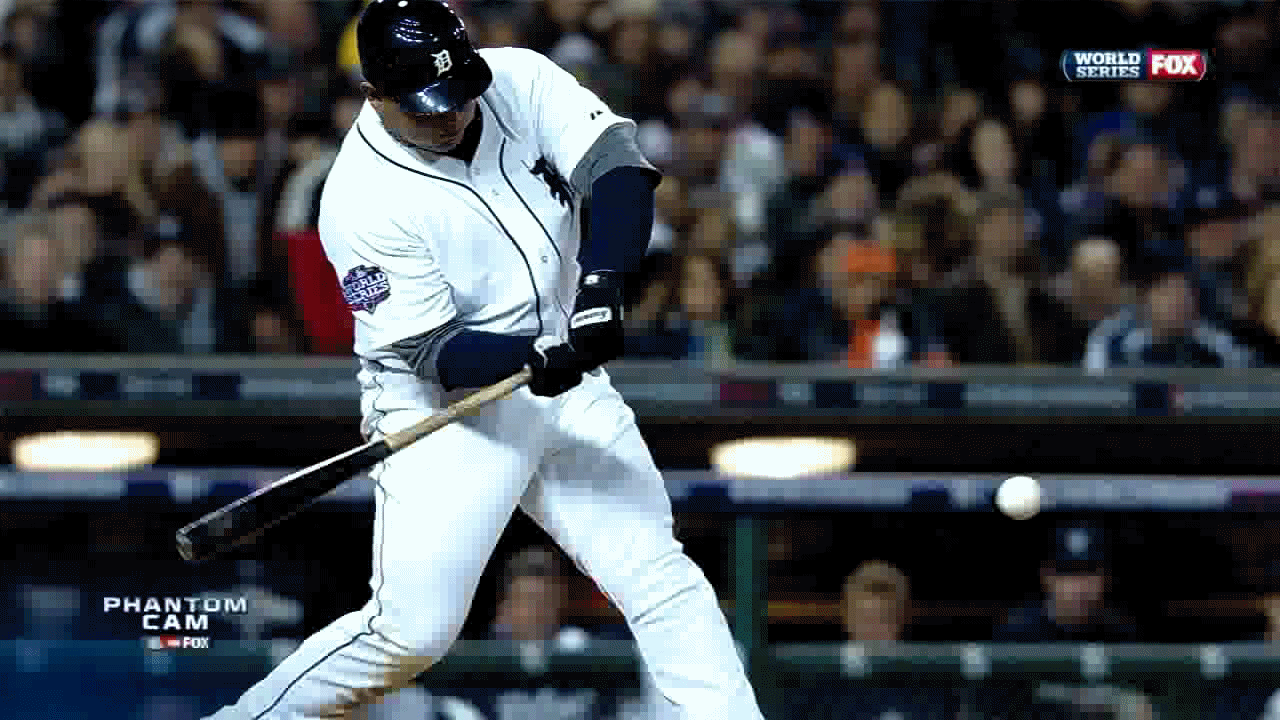Analysis of the Vibrating Broken Bat
During Game 3 of the 2012 World Series in the bottom of the 8th inning, the Tigers Miguel Cabrera came to bat against the Giants Tim Lincecum. He ended up hitting a weak grounder to 2B, and in the process he broke his bat. But the really interesting thing is the fate of the broken bat. Notice that it continues more or less on the same trajectory as it had before making contact with the ball, albeit at a slower speed. But notice also that the bat is vibrating, and it is that feature that I want to analyze further in this article.

In particular, I want to estimate the vibrational frequency of the bat and compare it with other bats I have studied. First, by playing back the video frame by frame, I determined that the vibration undergoes one full cycle in 4 frames. If I knew the frame rate of the camera, I would be able to determine the period of vibration, the inverse of which is the vibrational frequency. I had no a priori knowledge of the frame rate but I could figure it out using other things that I know.
So, how do I figure out the frame rate? First, I know the speed of the incoming ball as it crosses home plate, 83.2 mph or 1465 inch/sec, from the PITCHf/x tracking system. Next, I use the diameter of the ball, 2.9", to determine the camera calibration, which I find to be 15.15 pixels/inch. Next, I track the incoming ball frame by frame to determine that the ball advances 15.6 pixels/frame. That is all we need to determine the frame rate of the camera, which is equal to (15.15 pixels/inch)*(1465 inch/sec)/(15.6 pixels/frame) = 1422 frames/sec. For those of you conversant in dimensional analysis, note that the units all work out correctly. Now, this whole process is a bit crude but is probably the best one can do with the information we have. Nevertheless, it is quite likely that the actual frame rate is a more standard number of 1500 frames/sec, or about 5% larger than I determined. For this analysis, I am not worried about 5% effects, so I will just use the number I found.
Returning now to the vibrational frequency, it is simply (1425 frames/sec)/(4 frames), or 355 Hz. When I first discovered this result, I thought I had made a mistake. Over the years, I have studied many bats and they all have frequencies that are typically about half of this one. Now you can see why I was not interested in 5% effects, since I have a much larger effect--a factor of two--that I am worried about. But then it occurred to me what was different: This bat is shorter than a typical bat since the bottom of it has broken off, and the vibrational frequency is expected to be higher for a shorter bat. The qualitative physics argument is really very simple: It is easier to bend a longer object than a shorter one, all other things equal, so the bending frequency is expected to be higher for the shorter bat.
To check this out more quantitatively, I did a calculation using the bat simulation program I wrote more than a decade ago. First I took a typical wood bat with an R161 profile, 34" long, 31 oz in weight, and found the lowest vibrational frequency to be 179 Hz. Then I removed the bottom 6" of the bat (the knob and some of the handle) and redid the calculation and found that the lowest vibrational frequency increased to 352 Hz, almost exactly the value determined from the video. Given the crudeness of the measurement (remember my 5% error, not to mention the uncertainty in the 4 frames per cycle), the near-perfect agreement is certainly fortuitous. But the essential point remains that a higher frequency is both expected and found for the shorter bat. As a final remark, note that the vibrations persist for a long time after the collision, unlike the case for a hand-held bat. But this makes good sense since the broken bat is completely free and therefore does not experience damping due to the grip of the hands. Physics really does work!



